Big Night Out
Isolated by lack of transport and almost impassable roads, the first settlers at turn-of-the-century Kingston had to make their own entertainment. The first social activities centred on families and the “home entertainment unit” was usually a player piano around which family and friends gathered to sing. For those addicted to cards, there were card parties at people’s homes, and later, those of marriageable age arranged their own picnic outings by horse drawn ‘drags’, to places as far away as Ferntree Gully. Bicycles were all the rage, and there were many cycling groups around the Cheltenham, Dingley and Heatherton area.
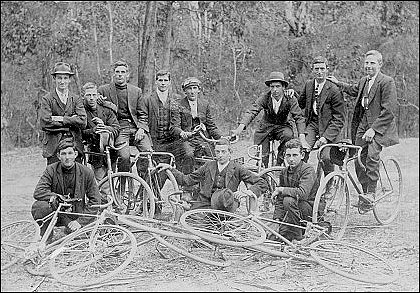
A group of Bike Riders from Dingley.
Tess Bone started to learn the piano when she was eleven, and both her aunts played, she says. “On Sunday nights, we’d all go over to my mother’s sisters, so around the piano we would have a sing-song,” she remembers. [1] Even though there was not much money, Bob Wright says his parents had a player piano, and there was a sing-song around it once or twice a week, for customers and friends. Good healthy activities for all, he says, with something for everybody. As far as the boys were concerned, they played marbles or cherry-bobs or something like that while the adults sang, he remembers, and mourns the fact that today, children no longer have those kinds of social activities for their entertainment. [2]
Bob Robertson remembers that neighbours would gather for social evenings at one another’s homes. “They used to put on dances and people would come from miles around. Everybody had to take a plate for supper, and Grandpa Beasley boiled the kerosene bucket full of coffee made of milk. That was his job,” he maintains. Bob’s family had no player piano, so an accordion was the next best thing to set the feet a-tapping. “There was a fellow called Fraser who had an accordion, and we used to get him to play the music,” he recalls. “He’d get an old time dance- a barn dance going- and he’d never stop. Those that didn’t dance were playing cards in the other little rooms they had there.” [3]
Euchre and Card nights filled any dull evenings at home. Norm Stephens remembers that his mum and dad played cards. “Of course back in those days, I can remember as a kid, that playing cards was a great thing. There were Euchre Parties at our place. I had to go to bed of course being so young, but they would be in there, playing Euchre.” [4]
“My mother used to try and sneak off to Euchre Parties. Just to stay sane,” says Alf Liddell. “She often used to win. She was very cluey with knowing where the Jack and Ace, or other cards were.” They would meet in a hall or a private home, he says and goes on to say that if it was for a charity, it would most probably be held in a private home. “They’d have their special charity… some woman with a bit of money would support a private charity,” he explains. [5]
There were privately organized ‘Drag’ Picnics, which were held in Cheltenham before the First World War, says Len Allnutt. The lads would group together to hire a horse drawn four-wheeled vehicle called ‘Drags’ which had seats down both sides. The boys would buy the tickets, and the girls would bring lunch. No one remained without a partner, because they would be “teed” up with someone for the day, says Len. “Quite a few romances would come from the ‘Drag’ Picnic. But quite a lot of the romances started around the churches and football clubs, … The football and the cricket clubs would have dances to raise money, and that sort of thing. Many others just picked up with a girl at school and never parted. So that was how they met,” says Len. [6]
Once the railway line connected the city with the beach suburbs, holidaymakers came in droves, to enjoy the beauty of the beaches. The ‘campers’ came in holiday and club groups to rent houses and camp on the foreshore, ‘with the men attired in striped blazers and creams, while the girls were fashionably dressed in skirts nipped at the waist, worn with frilled lace blouses.’ [7]
They made their own brand of entertainment in commercial marquees; camped in luxurious tents on the beachfront, or in their holiday houses. Jack McCarthy, who was in charge of Chelsea station in 1908, remembers that Birtchnell Bros. & Porter had a marquee near The Strand, ‘where in addition to land transactions, parties and entertainment around the piano were regular occurrences in the summer months.’ [8] Bertha Armstrong writes that John Porter of Birtchnell Bros & Porter who had a seaside house on the south bank of the Patterson River, had concert parties brought down from the city for much appreciated entertainment and fundraising events [9] Amelia Henderson recalls that her father Mr. Davis’ Glenworth Tearooms in Mentone had beautiful rattan furniture, and that they sold hot water to the holidaymakers and campers during the whole holiday season. [10] There were always customers, because women and children would remain camped at the beach for the entire school holidays, and their working men would come back by train at the weekends.
Then there were those who had their own holiday homes at the beach. Don Smibert says that his grandfather and grandmother James and Clara Evans’ holiday home at Aspendale became a favourite gathering place for family and friends during the festive season. At holiday time people would come down and pitch tents on their property, he says. Friends of the family would have a very good time. They’d just get around a campfire and sing, as there wasn't much else to do, he recalls. “I think a few played musical instruments but they liked to get around the fire and sing, or they’d swim and hike down to the Mordialloc Creek. I remember my Mother came back from the island by the Mordialloc creek- and she carried back some firewood that she gathered in her arms. She put it down at the back door of the house. They had a pet kookaburra that was sitting up in the spouting of the house and it cocked its head to one side and flew down and pulled a snake out of the wood she’d carried back,” he remembers with a mixture of delight and horror. [11]
Bathing and swimming were favourite pastime, but Phillip Coffey remembers in his memoirs that ‘neck to knee swimming costumes were mandatory for women, and were also worn by men. Beach inspectors patrolled Mentone Beach to enforce standards of attire then considered desirable. Rules of attire, he writes, however were not always observed. Shoulder straps were lowered.’ [12]

Boys at the Beaumaris Baths c1910. Courtesy Betty Kuc.
Another favourite event at the beach in those days, was watching the professional fishermen haul in their nets at dusk, Phillip Coffey records in his memoirs. ‘With trousers rolled up to their knees, the fisherman waded from the shore whilst straining with the lines. It could have been a re-enactment of Peter’s life in Galilee,’ he remarks. [13]
As the community began to take shape, people joined in social activities designed for a specific purpose. Soirees, socials and concert parties were held to raise funds for churches and public buildings. Football, cricket and bowling clubs, and services such as the Fire Brigade had committees and Ladies’ Auxiliaries to stage social fundraising events for equipment.
Bertha Armstrong, daughter of a pioneering settler in Chelsea, William Black, recalls that her mother was the treasurer of the committee, which built St Aidan’s church. Mr. John Porter of Birtchnell Bros & Porter was the secretary, and the proceeds of concerts held at his house together with dances at the Wine Saloon owned by a Mr. Rigby, were used to build St. Aidan’s Church in 1902. [14] The concerts and dances continued to be very successful in raising funds and St Chad’s was built in 1914 on a property bought in Thames Parade. Bertha Armstrong recalls that they were honoured by the presence of “Rev. Brooksbank Anglican Minister’s daughter Lady Dixon and her husband Sir Owen Dixon coming down in later years to receive the first debutantes at our first Parish Ball held in the old Pelaco Hall in the strand.” [15]
Alf Priestly maintains that leisure in those days was turned to community effort at something. In Carrum, he says, there were three resident’s associations with their own hall, and each of these hardworking associations raised money for kindergartens and schools. [16] To celebrate the achievement of building Edithvale Primary School in January 1913, a Complimentary Social was held on August 30, 1913, in honor of Herbert John Richardson, President of the Aspendale Progress Association during 1912/13, where ‘an enthusiastic audience saw Mr. Richardson receive a handsome silver tea and coffee service, a salad bowl, gold chain and pendant for his hard work’. The Aspendale Progress Association has continued to work hard for the community to the present day, and counts the opening of Edithvale Railway station in 1919 and Regent’s Park in 1924, among its many successful projects. [17]
Norm Stephens remembers that his father was highly involved in the dances held by the East Carrum Ratepayers Association, to raise funds for various things. “Mr. Peterson used to have a squeezebox. He played us the music, and Mrs. Staples taught us to dance,” he remembers. “All the older ladies would go out there, and us young ones would go along. That’s where we learned to dance,” he says. [18] “We graduated to the Mechanics Hall then. And we used to run dances up at the Fire Brigade on Thursday nights. Dad was one of the ones that started the dances off. I used to go over with him when I was a kid, and get the hall ready. Sawdust on the floor, candle grease on the floor, then we’d get a box- a fruit box on top of a bag with bricks in it- and drag it around the hall to shine the floor up, to make it slippery,” says Norm. [19]
Roy Sullivan, who had a vegetable garden in Chesterville Road, was a football fanatic, says Len Allnutt, and supported the Moorabbin Football Club with his brother. He had a strong Ladies’ Auxiliary and Moorabbin had more money than anybody else. And where the other clubs’ players were playing for nothing, Moorabbin was giving every man ten bob to play, Len claims. They had the best players and went on to win many premierships, he says. [20]
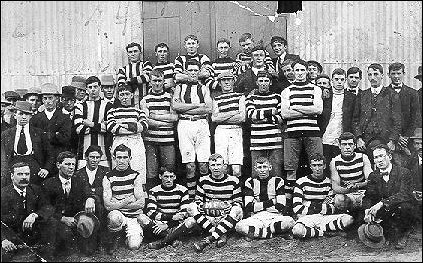
Moorabbin Football Club.
Once churches, school, and halls were established, they automatically became venues for social activity. The church was a focal point for the community, with Sunday School Picnics and an Anniversary/Concert Day to which everyone flocked to hear their children sing or see them perform. But it was also a chance to be together with other people.
Sunday Schools provided entertainment for the children who attended, willingly or not, throughout the year. “You would have your tea meeting near the Anniversary of your church and Sunday School, and then you’d have a concert that night,” says Alf Liddell, who was a prized pupil at his strictly Primitive Methodist Sunday school. “They tried to get nearly all the kids in the concert, so that their parents could see their kid up on stage. That was great. And old Mrs. Porter, the minister’s wife, was brilliant, brilliant with the play. Every kid had a part. She would make up a cantata, and do it herself. And old Mrs. Shield’s, a relative of my mother’s was a pianist. She lived in The Glebe, in a big old home, beautiful old home with a verandah all around, little fireplaces and all that. It was the British Embassy, her home,” he recalls fondly. [21]
Mary Chapman says: “After Mass it was real fun. There’d be a big circle of us all chatting away. And my brother who was a bit of a wit would say `Long Live the Kellys’ (that was our name). It was a great opportunity to meet people.” [22] Tess Bone remembers that her parish priest, Father Martin was a real man’s man. He had been in the navy, which is possibly why his outlook was very tolerant, she recalls. He had no prejudice against those of differing beliefs, and invited students from other denominations to join in social activities such as gym, and marching competitions at her church, she says. [23]
Churches also had amateur sports groups and choirs. “Women were tennis players and into dancing,” says Joe Souter. “There were three tennis clubs in Dingley. There was the Heatherton, which was on the border, the Dingley Church Tennis Club, and the District Tennis Club, which was opposite the hall up at Dingley.”[24] May Keeley recalls that her parents both sang in the choir at church, and that they held a minstrel show in the old City Hall, where they used to have to put buckets to catch the rain because the roof leaked. [25]
Mary Chapman loved the dances at the Heatherton Hall, which was just across the road from her, she says. But she also loved Tennis in her spare time. “We played Tennis, “ she says, “Next door! Competition tennis! We used to play with the Stooke boys – they lived over the road from us,” she recalls, “ and they were very good.” But Mary was no laggard in the sport. “I had this MASSIVE serve which was very good, ” she admits. [26] Tess Bone liked tennis with the boys for the same reason. “They made me hit harder, “ she says. “One time a curate who was rather keen on tennis came in his nice white creams and started to play with us. You’d forget that the father was down the other end, you know, and oh! B---low. You were going to say something and you’d realize that he was down the other end.” [27] Just as a point of interest, tennis shoes, says Joe Souter were actually whitened with the residue that was created by the generator in the Attenborough’s church at Dingley. “The residue of the gas was like lime in the gas generator, which you emptied about once a week, or a fortnight, or something like that. It was a pretty big generator… and everybody in the Sunday school or in the church tennis club, would pinch this stuff and whiten their tennis shoes with it. Everybody used it,” he says. [28]
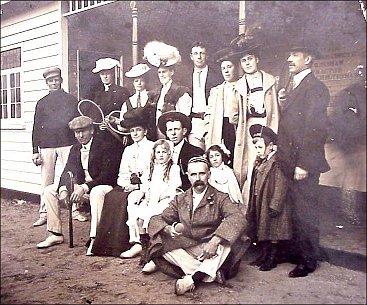
Members of the Cheltenham Tennis Club outside their pavilion in Cheltenham Park. Courtesy of Betty Kuc.
Diverse organizations, committees, clubs, lodges and associations established ongoing functions and events to showcase the achievements of the community.
Len Allnutt and Ken Smith recall the Annual Agricultural Shows at Cheltenham. “It was a full Agricultural Show, horses and cattle, vegetables, and also these novelty events with horses going in a barrel race, and all this sort of thing,” says Len, whose grandfather was on the Show committee. [29] Ken Smith remembers that there were three big sheds at the Cheltenham Show. “The first big shed was for the ladies sewing and knitting and that sort of thing,” he says. “The next shed was for all the market gardeners, and the third shed would be all the ‘chooks’ on display. They all had to be cleaned and brushed up, and made to look nice,” he recalls. Then, says Ken, they used to have horse running and horse jumping on the oval, and further up on the northern side of the oval, on a bit of flat land up there, they had all the side shows, the merry go rounds and the slides and those sort of things for the kids. [30]
Lodges also held annual events for public enjoyment. The shows held at Cheltenham had processions that used to go down Cheltenham’s main street with the van in front of them and decorated carts, says Ken Smith. [31] Len Allnutt adds that there were a number of lodges in Cheltenham in those days. Two of these were The Oddfellows, and The Australian Natives, he says, and on a gala day, they had a procession from Moorabbin down to Cheltenham down the main road and they’d have floats and a lot of the lodge members would march in their regalia. “My grandfather George, he was the Marshall of the Parade, he used to lead the Parade on Horseback,” he says, “That parade went until after the First World War.” [32]
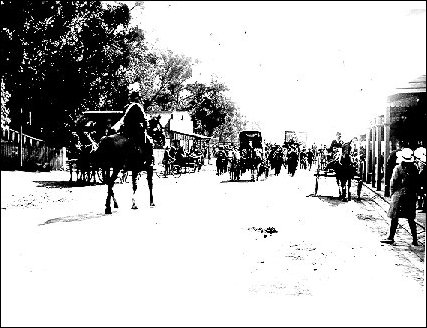
Len Allnutt’s grandfather on horseback in the Gala Parade in Charman Road, Cheltenham.
The community by now had grown enough in numbers to stage annual balls, carnivals, picnics and sporting events for the whole community to enjoy. Dancing was part of everyday life, but a highlight was the Annual Ball. Len Allnutt recalls that ‘The Rangers’ and others had Annual Balls, to which everyone went. There was always a big turn out. The entertainment was nothing like it is today, he says, but people would come to the ball from far and wide, to partake of the tremendous suppers, music and dancing. “It would be a big night,” says Len. “Councillors and leading citizens would organize things, sometimes anonymously,” he says. “The leading lights would see that everything was in order. People would come to them for help… and they would help, so that everyone would have a good time.” [33]
The Benevolent Society Fancy Dress Ball was held at the Melbourne Benevolent Home in Cheltenham. Nurses obviously would not go out much because their pay would not run to hiring a cab and paying their fare to town too often. They were more or less isolated, and they had this great big hall, so they could hold the functions in the hall, says Len, and they would make their own fun. There were also different organizations allowed in the area, he remembers, and they would put concerts on in the hall. These concerts were to some of the residents as well, Len explains. [34]
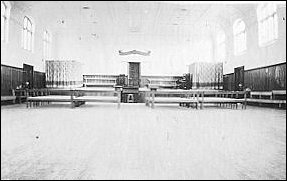
Hall at Melbourne Benevolent Home in Cheltenham. Courtesy Len and Dorothy Allnutt.
Larrikins, jokesters and shenanigans at local carnivals and festivals gave birth to yarns, which are still being handed down to the present generation. The Mordialloc Carnival started in ’23 or ’24 to raise money for the local charities. It ran from Christmas till Easter over the holiday period. They had boxing troops and they had The Wall of Death, the Bloke on the Motor Bike… and a Snake Charmer, Len Allnutt recalls, and tells the following yarn about the last mentioned act in which a woman put snakes around her neck, and handled them without fear. [35]
“Now a fellow who worked for us- a bit of a wild one- had a bit of a fascination with snakes. He would pick them up and put them in a cage at home. Someone told him about this snake charmer at the carnival, so he gets a snake out of the cage, and puts it in his shirt, and takes it down to the carnival. He hears the spruiker say- ‘Come and see the Wonder Woman… she’s not frightened of snakes… she’ll handle 12 snakes at once’- and the whole crowd is in there watching her. Her partner tips the snakes out of the bag, and everyone is watching them wind around her arms, all around her, these dozen snakes. [36]
The fellow with the snake in his shirt was getting ready to put a twist on the performance, towards the finale. “At the end of the act, they started to put the snakes back in the bag, and while their backs were turned, this fellow whipped the snake out of his shirt, and aimed it amongst the dozen she had handled,” says Len. “When they came to get the twelfth one, there was one spare. They all stopped dead!” Len says, savouring the moment. “The spruiker didn’t know what was wrong,” he goes on, “and the woman’s looking!” he says. “They tipped the snakes out and counted them again. There was still one left over! And he (the fellow who threw in the extra snake) just turned round and left them all there to figure it out,” he recounts with glee. “I don’t think they (the Snake Showmen) ever found out how it happened. That’s the sort of thing they did to make some fun in those days,” he says. [37]
Len also recalls that at Cheltenham, everyone used to go down to the Carnival on Christmas Eve and New Year’s Eve. “There used to be crowds and crowds down there on New Year’s Eve, and they had the Dance Palais going. We used to pay sixpence to go in and then three pence to dance. All the girls would sit along in a row, and you used to pay three pence to go and have a dance. It used to go practically non-stop,” says Len. “The Dance Palais floor was something like the Dodge’ems, but it was really a dance floor. There were gates, which they would open on one side when we went in, and when the dance was over, we went out on the other side of the gate. So there was only a two or three minute wait between the dances!” he points out. [38]
The Heatherton Carnival was the most popular event by far for young and old alike in those days. Sylvia Roberts recalls it with joy. “Oh! The Heatherton Carnival was on the last day of November,” she recalls. “We got a new dress, our only new dress for the year! And we all went decked out, didn’t we, and dad was on the chocolate wheel. Us kiddies could all run like the jolly wind, and we’d bring home quite a bit of prize money. Enough for our Christmas shopping!” she says. [39] Alf Liddell, her brother, elaborates on their father’s role on the chocolate wheel. “My dad was at the stall with the weighing machine. You had to guess the lady’s or gentleman’s weight, and if you were within 4 pounds, you got a box of choccies,” he says. [40] Joe Souter adds that the Heatherton Carnival was fabulous. “It must have gone for more than a day. Of course there were horse races and draught horses had to walk, trot and gallop. The draught horses had to trot a circle and gallop. Some good horses were brought to race at the Carnival, too,” he remembers. [41]
Among the more elite leisure activities, Joe Souter reports the unusual sport of fox hunting. “There was a hunting club at the South Oakleigh or Oakton Junction,” he says. “Hounds and Huntsmen used to congregate outside the Old Dingley Church, in their red coats and their hounds. They’d have their Hound master with them, and would gather there and then they would leave and hunt foxes up in the Keysborough area,” he recalls. [42]
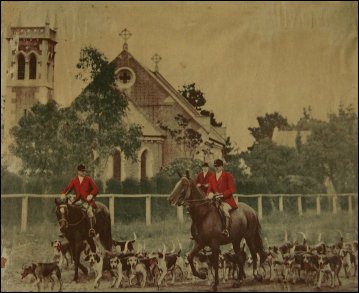
Huntsmen outside Christ Church, Dingley.
Life-saving was a wonderful service and source of entertainment at the same time, with the establishment of the Henley Carnival held on the Patterson River at Carrum in the 1920s. There were decorated canoes and boats, and events like the greasy pole and pillow fights for the masses in those days. [43] They held a Queen of the Carnival competition to purchase equipment, and he remembers his sister was named Queen of the Life-Saving Club, and another girl, Francis Barnes was pronounced the RSL Queen, and that raised a lot of funds, says Bob. He knows that his father and uncle were two of the first lifesavers in Victoria, with Certificates from the Royal Life-Saving Society in London and that his father was also a Life Member of Chelsea, Carrum, Edithvale, Mordialloc and Mentone Life-saving Clubs, and chief of Life-saving at the Henley Carnival for years. “He had a beautiful blazer… it had a real gold thread pocket, of the Royal Life-saving Society of London, of which he was President,” says Bob, who inherited his father’s passion. “Life-saving was a big part of our lives!” [44]
Young ladies and gentlemen enjoyed the annual picnics and outings, which allowed them to pair off on trips and sometimes, disappear into the bushes. This resulted in many a romance and marriage. It may also have resulted in swelling the ranks of the “Wayward Girls Home” in Cavanaugh Street, Cheltenham- (or the “Naughty Girls” Home as it was fondly referred to by the locals.) [45]
Len Allnutt recalls that the annual picnics were so popular, that the picnic groups had to find new places to accommodate all the merrymakers. “It was so crowded down at Keys Park … you couldn’t get any parking. You couldn’t stand up! Then they shifted,” he says. “The Methodist Church shifted to a farmer’s paddock out at Narre Warren. That was something great!” he remembers. “That was a big trip in those days! It was in the early days of motor trucks,” he explains, “and the gardeners would bring all their trucks and take all those kids to Narre Warren. You’d have thought you were going about a hundred miles to Narre Warren, and they had this paddock all to themselves where they could have the Picnic Races,” he goes on. “Oh! That was a great thing! Then some of the young bucks went off with the girls and got lost, and came back late! They were great days. They’d sing songs going out in the trucks- going out and coming home,” he recalls with great pleasure. [46]
Another great annual event was the Gardeners’ Picnic run by The Vegetable Growers’ Association, and held on a Thursday in February. The organizers would hire a boat to either Sorrento or Queenscliff, for a Picnic in the Park. “It was a great social event in its day,” says Len Allnutt, “especially for the young bucks and their girlfriends, it was a day out, down the bay. It was a great time, socialising on the boat. A three-hour trip. Down the bay… walking around talking to one another, blokes having a drink at the bar,” Len fondly remembers. [47]
When there was really nothing better to do, children and adults would make their own entertainment. Some of these activities were innocent. Joe Souter as a child, for example, built himself a Billy Cart. “Oh I put pedals and things in it. Never got the pedals to work properly, but we took turns to push one another around. We were always mechanically inclined. None of us were ever taught. It was just natural. Just came out of the blue,” he says. But Joe also devised downright wicked entertainment with his brother, by setting small fires alight on the farm next door where their neighbour was trying to burn off. They hid in the dark, and watched their portly neighbour run frantically from one to the other trying to extinguish each new blaze whilst cursing and wondering how the fires could possibly have started. Of course, Joe had his just come-uppance, when a snake bit his brother while they were crouching in the grass enjoying it all. His brother was ultimately saved, but Joe was in deep trouble. [48]
Sometimes this home-made entertainment was exhilarating and dangerous, as Ken Smith recalls. “Oh! It was a lot of fun,” he says. “We had big gum trees on our property and my father used to tell me to climb up the gum tree and I’d go up to about 20 foot, and he’d chop it down and I’d ride the gum tree down to the ground.” At other times, out of sheer boredom, he would dig holes and fill them in to pass the time away, he says. [49]
Later, Radio replaced the player piano for home entertainment, and movies took the populace outside the home in masses.
Alfred Deakin, 1857-1919, Prime Minister of Australia, 1903-1910, was an avid supporter of the ‘new’ telecommunications industry. He was present when the Marchese G. Marconi sent the first overseas wireless messages overseas from Point Lonsdale, in Victoria, on July 12th 1906. The first direct wireless message from England to Australia was received on 1918 and Post Office Beam Wireless services had been established by 1927, but High Frequency Radio did not begin transmission of broadcasts until 1934. [50] When it did, Ken Smith recalls that reception was not as easy to get as it is today. “Well, my dad went to Cauldwell’s Timber yard and got two great big thirty foot Oregon poles, and wires. He put two big poles up, and he bought a crystal set from Mr. Phelan, and we could sit at night, listening to the broadcasts,” he says. “Our favourite thing was listening to the wrestling at night when Norman McCann was broadcasting. We’d hear- ‘He can’t get out! He can’t get out! He’s out of it! He’s out of it!’- and my father and I we’d finish up wrestling on the floor. ‘Give up! Give up!’ we’d cry, and we’d have a headlock on each other and of course my poor mother was upset, and that’s what I did for sport!” he says [51]
Silent movies and then the talkies enthralled audiences in Picture Theatres from 1929. Len Allnutt has vivid memories of both silent movies and the talkies. “The first pictures I remember were the silent pictures, and they used to show them on Saturday night at the Soldiers’ Hall where they played the Bingo, up near Southland. They also had them down at Mentone, at the Recreation Ground, in a galvanized iron building, (which was later turned into a skating rink) and that was where they used to have the matinees,” he remembers. They used to have old silent pictures. Tom Mix was the cowboy and the dog was Rin Tin Tin, he says. All the kids would go down there to see Tom Mix on a Saturday afternoon, or go and see Rin Tin Tin. Years later, old Jack Warner (of Warner Bros.) before he died, admitted that there was no one dog called Rin Tin Tin. They had many dogs making the film, he says, laughing at their gullibility at the time. [52]
Len also recalls his nights out to the talkies at the new Mentone Picture Theatre. “After tea on a Saturday Night I would say to my father, ‘Give us a couple of bob,’ and I’d walk down to the theatre. I’d buy the Sporting Globe for a penny ha’penny, read the football results, go to the back stalls, for one and seven pence ha’penny and then I had thruppence left for an ice cream at half time,’ he remembers. “It was a BIG night out,” says Len.
Footnotes

